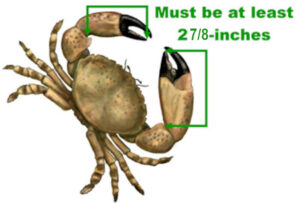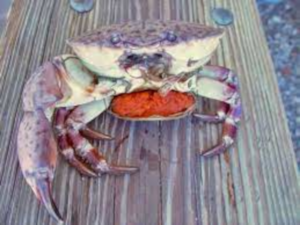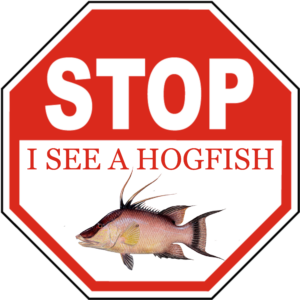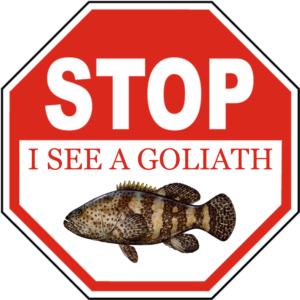The onset of winter in Florida not only brings wonderfully mild sunny weather but also the eagerly anticipated annual harvest of stone crab claws. The Crustacean Fisheries group at the Fish and Wildlife Research Institute (FWRI) is responsible for monitoring the commercial stone crab fishery along with conducting research on the population of stone crabs in Florida. The widespread popularity of stone crab claws leads many people to inquire about this unique Florida resource. The following are a list of frequently asked questions about this resource.
When can I harvest stone crab claws?
In Florida, stone crabs are legal to harvest from October 15 through May 1.
How are stone crabs harvested?
The main harvest method used in both the commercial and recreational fisheries is a baited trap (Figures 1 and 2). Some recreational crab fishers collect crabs by hand (using scuba or snorkel gear). Most fishermen use traps. In the commercial stone crab fishery, traps are put out in long lines of up to 100 traps where each individual trap is buoyed. Recreational crab fishers are limited to five traps per person and a recreational saltwater fishing license is required by the harvester.
How are stone crab claws measured?
 The size of a stone crab claw is considered to be the length of the propodus. The propodus is the larger, immovable part of the claw. Legal-sized (harvestable size) claws are 2 7/8 inches or greater in propodus length. The measurement is taken from the base of the propodus (at the joint of the elbow) to the outer tip of the propodus (Figure 3). In general, male claws are larger than female claws for a crab of the same carapace (shell) size. The largest male claws are about 140 millimeters (mm), or roughly 5½ inches long. The largest female claws are about 120 mm (4¾ inches). The largest stone crab claw collected by the FWRI researchers was 148.9 mm (5 3/4 inches).
The size of a stone crab claw is considered to be the length of the propodus. The propodus is the larger, immovable part of the claw. Legal-sized (harvestable size) claws are 2 7/8 inches or greater in propodus length. The measurement is taken from the base of the propodus (at the joint of the elbow) to the outer tip of the propodus (Figure 3). In general, male claws are larger than female claws for a crab of the same carapace (shell) size. The largest male claws are about 140 millimeters (mm), or roughly 5½ inches long. The largest female claws are about 120 mm (4¾ inches). The largest stone crab claw collected by the FWRI researchers was 148.9 mm (5 3/4 inches).
What are the regulations on females with eggs?
 Females carrying eggs are called ovigerous and their egg sacs are known as sponges (Figure 4 and 5). Ovigerous females are easily identifiable by the orange or brown sponge the female carries under her. The sponge is revealed when the crab is picked up or turned over. All crabs should be checked for the presence of a sponge prior to declawing. If a sponge is detected, the crab must be placed back in the water immediately and unharmed. Extended periods of time out of the water can damage the delicate eggs and cause a female to drop the sponge. Once dropped from stress or damage, the sponge, and eggs contained in that spawn are lost. It is illegal for anyone to harvest claws from ovigerous females.
Females carrying eggs are called ovigerous and their egg sacs are known as sponges (Figure 4 and 5). Ovigerous females are easily identifiable by the orange or brown sponge the female carries under her. The sponge is revealed when the crab is picked up or turned over. All crabs should be checked for the presence of a sponge prior to declawing. If a sponge is detected, the crab must be placed back in the water immediately and unharmed. Extended periods of time out of the water can damage the delicate eggs and cause a female to drop the sponge. Once dropped from stress or damage, the sponge, and eggs contained in that spawn are lost. It is illegal for anyone to harvest claws from ovigerous females.
How many eggs does an ovigerous female carry?
The number of eggs that a female produces is related to her body size. Small females produce tens of thousands of eggs in a sponge. Very large females can produce up to a million eggs per sponge and may produce four to six sponges in a single spawning season.
How often do females mate?
Females are only able to mate immediately after a molt, or when the crab sheds its smaller shell, while their shells (exoskeletons) are soft. Female molting and mating occur in the fall (mostly September through November). Females retain the sperm received during the fall mating season for up to a year, or until the next season’s molt. Sperm is stored in two sacs over the winter and used during the following spring and summer spawning season to fertilize the eggs of each sponge.
How can I tell male from female?
The best way to distinguish male and female is to remember wide females and tall males. Female stone crabs will have wide round abdomen, while male stone crabs will have long narrow abdomen.

How long does it take a crab to re-grow a claw?
Once a stone crab loses a claw or other appendage it takes several molts to fully regenerate the lost appendage or claw (Figure 8). Each time a crab molts it has the ability to regenerate the lost appendage. Regeneration in adult crabs takes one year due to the seasonal molting of adult females in fall and adult males in winter. The regenerated claws start out smaller than the original and will continue to grow through subsequent molts. After three molts (three years in adult crabs) a claw can regain 95 percent of its original size. In juvenile stone crabs, regeneration of lost appendages can be more rapid than adults. Juvenile crabs molt two or more times per year giving juveniles the ability to regenerate an appendage in a few months.
Stone crabs lose claws in two ways: the claw can be forcibly broken off when it is harvested by fishermen or lost in battle; or, a crab can intentionally drop any of its legs or claws if they are damaged or sick. A stone crab can re-grow either of its claws only if the joint that linked the claw to the body is left intact. This is why it’s so important for fishermen to correctly break the claws off of the crabs
What are the survival chances of the crab with one or two claws missing?
The answer to this question requires three key components:
Type of wound: Stone crabs have a much better chance of survival if the diaphragm at the body/claw joint is intact. The diaphragm functions as a seal to close the wound and stop the bleeding. In the wild, the survival rate may approach 100 percent. But in a fishery, the survival rate depends on the fisherman breaking the claw correctly. How the crabs are handled by the fisherman both before and after the claws are removed is also important.
One claw or two: The only declawing study that has been published (Davis et al., 1978) reported 47 percent of the crabs declawed by double amputation died from the trauma while 28 percent of crabs with a single amputation died.
Size and sex of crab: Large crabs of both sexes most likely never fully regenerate claws due to their relatively old age. The largest males in a population have the highest fishery-related mortality because traps are very effective at capturing the largest crabs in a local population and because a very high proportion of a large male’s body weight is in the claws. Concern is raised about the survival of the largest males because these males are the prime mating males and they are essential to the health of the fishery.
If a stone crab loses both claws how can it eat and defend itself?
Upon losing both claws stone crabs change their behavior from predator to scavenger. They rely more on concealment and scavenging rather than foraging in more open areas. Feeding for stone crabs without claws is likely more difficult, particularly if there is competition for resources and to hold territories. Defense against predators would also be more difficult or require a different strategy. However, their main predator, the octopus, is designed to prey on them whether they have claws or not.
How do I know if the claws have been regenerated?
When the claws are folded into the body, pull the claws out. On the inside of the propodus will be lines that look like a fingerprint. If those lines are unbroken, the claw is an original claw. If the inside of the claw looks like a series of dots and/or dashes, it is a regenerated claw.
How long do stone crabs live?
Currently, there is no precise method of determining the age of stone crabs. Age is estimated based on molt frequency and average molt increment. The age estimates suggest wild males live for seven or eight years and females live up to eight or nine years. In fished populations, it is unlikely that stone crabs will live to the maximum age. (Restrepo, 2004)
Literature Cited
Davis, G. E., D. S. Baughman, J. D. Chapman, D. MacArthur and A. C. Pierce. 1978. Mortality Associated with Declawing Stone Crab, Menippe mercenaria. South Florida Research Center Report T-522. 23 pp.
Restrepo, V. 2004. Growth estimates for male stone crabs along the southwest coast of Florida: A synthesis of available data and methods. Transactions of the American Fisheries Society 118(1): 20-29.
References
Bert, T.M., J. Tilmant, J. Dodrill, and G.E. Davis. 1986. Aspects of the Population Dynamics and Biology of the Stone Crab (Menippe mercenaria) in Everglades and Biscayne National Parks as Determined by Trapping. South Florida Research Center Report SFRC-86/04. National Park Service, Everglades National Park, Homestead, Florida, USA. 77 pp.
Brown, K.M., and E.S. Haight. 1992. The foraging ecology of the Gulf of Mexico stone crab Menippe adina (Williams et Felder). Journal of Experimental Marine Biology and Ecology 160: 67-80.
Gerhart, S.D., and T.M. Bert. 2008. Life-history aspects of stone crabs (genus Menippe): size at maturity, growth, and age. Journal of Crustacean Biology 28(2): 252-261.
Muller, R.G., T.M. Bert, and S.D. Gerhart. 2006. The 2006 Stock Assessment Update for the Stone Crab, Menippe spp., Fishery in Florida. Florida Fish and Wildlife Conservation Commission IHR 2006-011
Source: http://myfwc.com/research/saltwater/crustaceans/stone-crabs/faq/
These Keys Treasures Designs and many more are available on products such as T-Shirts, Stickers, Magnets, Mugs, Phone Cases, and much more at KeysTreasures.ReBubble.com



